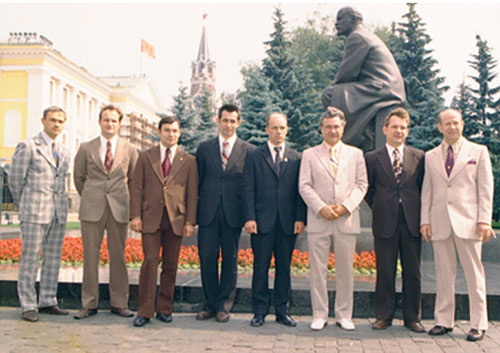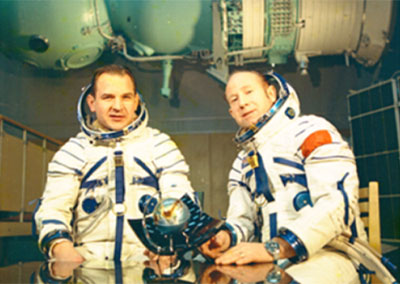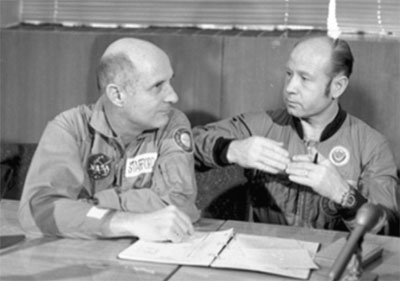The implementation of joint Soviet-American “Soyuz – Apollo” program (APAS) in July 1975 initiated the process of international cooperation in the domain of manned cosmonautics. The APAS program was approved within the frame of the USSR-USA agreement of May 24, 1972 on cooperation in peaceful investigation and use of outer space. The Center took the most active part in the project implementation at all stages.

The Soviet participants of the “Soyuz-Apollo” program (from left to right):
Dzhanibekov V.A., Andreyev B.D., Romanenko Yu.V., Ivanchenkov A.S., Rukavishnikov N.N., Filipchenko A.V., Kubasov V.N., Leonov A.A.
There were two American crews:
- the first crew – Th. Stafford, V. Brand, D. Slayton;
- the second crew – A. Bean, R. Evans, J. Lousma.
In the course of training under the APAS project cosmonauts Filipchenko A.V. and Rukavishnikov N.N. performed spaceflight in December 1974 with the purpose to test the modified spaceship “Soyuz” and androgynous peripheral docking assembly.

In the course of the mission from 15 till 25 of July, 1975 the docking of spacecrafts of different countries and cosmonauts/astronauts transfers from one spacecraft into another were performed for the first time in the history.

Aleksey Leonov, commander of “Soyuz-19” spacecraft, and Thomas Stafford, commander of "Apollo-ASTP", before flight
|
"Soyuz-19" spacecraft |
"Apollo-ASTP" spacecraft |
|---|---|
|
Crew:
Call sign- "Soyuz" Launch : July 15, 1975 at 15:20, Baykonur, launch site #1, LC 5 Landing – July 21,1975 at 13:55, 54 km to the north-east from town Arkalyk |
Crew:
Launch: July15, 1975 at 22:50, KSC, LC-39B Landing – July 25, 1975г. at 00:18, Pacific Ocean, 600 km to the west from Hawaiian Islands |
|
Flight duration: 5 days 22 hours 30 min. |
Flight duration: 9 days 01 hour 28 min. |
|
Flight features: the first international manned program, the first docking of spacecrafts of different countries (USSR and USA) |
Flight features: the first international manned program, the first docking of spacecrafts of different countries (USSR and USA) |
Missions of “Soyuz” space vehicles and “Salyut – 6” orbital station with international crews aboard under “Intercosmos” program became the following stage of international manned cosmonautics history in 1979-1981.
Cosmonaut candidates from Czechoslovakia, Poland and the GDR came to the Center to receive training in December, 1976. Cosmonaut candidates from Bulgaria, Hungary, Cuba, Mongolia, Rumania and candidates from Vietnam joined with them in March of 1978 and in April of 1979, correspondingly.
Total 9 manned missions with cosmonauts from the said countries were performed within the frame of “Intercosmos” program.
|
є |
Name (country) |
Date of launch and landing, MSV, station, flight duration |
Total flight duration (days/hours/minutes) |
|---|---|---|---|
|
1 |
Remek Vladimir (Czechoslovakia) |
02.03.78-10.03.78
(Soyuz-28) |
07.22.17 |
|
2 |
Hermaszewsky Miroslav (Poland) |
27.06.78 - 05.07.78
(Soyuz 30) |
07.22.03 |
|
3 |
Jaehn Sigmund (Germany) |
26.08.78 - 02.11.78
(Soyuz -31) |
07.20.49 |
|
4 |
Ivanov Georgy (Bulgaria) |
10.04.79 - 12.04.79
(Soyuz -33) |
01.23.01 |
|
5 |
Farkas Bertalan (Hungary) |
26.05.80 - 03.06.80
(Soyuz -36) |
07.20.46 |
|
6 |
Pham Tuan (Vietnam) |
23.07.80 - 31.07.80
(Soyuz -37) |
07.20.42 |
|
7 |
Tamayo-Mendez Arnaldo (Cuba) |
18.09.80 - 26.09.80
(Soyuz -38) |
07.20.43 |
|
8 |
Gurragcha Jugderdemidin (Mongolia) |
22.03.81 - 30.03.81
(Soyuz -39) |
07.20.42 |
|
9 |
Prunariu Dumitru (Rumania) |
14.05.81 - 22.05.81
(Soyuz -40) |
07.20.42 |
Hereafter international missions were performed on the basis of bilateral agreements. Two such missions were performed aboard “Salyut” orbital station, they are:
- the first – Soviet-French spaceflight in 1982 and
- the second – Soviet-Indian spaceflight in1984.
|
є |
Name (country) |
Date of launch and landing, MSV, station, flight duration |
Total flight duration (days/hours/minutes) |
||
|---|---|---|---|---|---|
|
1st flight |
2nd flight |
3rd flight |
|||
|
1 |
Chretien Jean-Loup (France) |
24.06.82 - 02.07.82 |
26.11.88 - 21.12.88 |
26.09.97 - 06.10.97 |
43.11.18 |
|
2 |
Sharma Rakesh (India) |
03.04.84 - -11.04.84 |
|
|
07.21.41 |
The higher level of international cooperation in the field of manned cosmonautics was reached within the frame of “Mir” orbital complex program.
At the first stage of this program international flights were performed according to classical scheme of visiting expeditions. The Soviet-Syrian (1987) spaceflight, second Soviet-Bulgarian spaceflight, and Soviet-Afghan spaceflight (1988) were performed similarly.
Hereafter international investigation programs in which foreign cosmonauts took part were implemented in the course of shift turnarounds of primary crews. Missions of cosmonauts and astronauts of France (three times), Japan, Great Britain, Austria, FRG, and European Space Agency (ESA) were performed just so.
The duration of foreign cosmonauts stay aboard “Mir” OC increased gradually. French cosmonaut Jean-Loup Chretien (the only foreign cosmonaut who worked aboard two Russian space stations – “Salyut-7” and “Mir”) worked aboard “Mir” station for 23 days. ESA astronaut Ulf Merbold worked on orbit for 30 days, 28 days of them he stayed aboard “Mir” complex.
>> »ностранные космонавты подготовленные в ÷ентре
At present foreign astronauts are often included in space expeditions for months. USA astronaut Norman Thagard was the first who together with Russian cosmonauts V.N.Dezhurov and G.M.Strekalov worked in space for 115 days in 1995. ESA astronaut Thomas Reiter, a member of the 20th primary expedition, acted as a flight engineer for 179 days.
For the first time foreign cosmonauts took part in EVA while staying aboard “:Mir” station. The initial experience of a spacewalk was gained during EVA of A.A.Volkov and Jean-Loup Chretien (France) on the 9th of December, 1988. From October 1995 through February 1996 Thomas Reiter preformed two spacewalks along with Russian cosmonauts S.V.Avdeyev and Yu.P.Gidzenko.
The intensity of international missions, extensive space activity and investigations greatly complicate Russian cosmonaut training process and mission performance first of all. Thus the 22nd expedition crew (V.G.Korzun, A.Yu.Kaleri) executed two-week Cassiopeia research program together with a French cosmonaut Claudie Andre-Deshays at the beginning of the mission. Then they were working simultaneously under national space program and along with NASA astronauts Sh.Lucid, J.Blaha, J.Linenger under “Mir”-NASA program for five months. At the mission final stage they took part in research and experiments under Russian-Germany space program along with a FRG astronaut R.Ewald.
Totally 50 primary and back-up international crews had received training at the Center by August 1996. 25 cosmonauts from 17 countries worked aboard the Soviet and Russian spacecraft and orbital stations.
An active and longtime partner of the Center is CNES (France). From 1982 through 1996 there were five joint flights and there are also rather promising perspectives for further cooperation. In 1994-1996 there were two space flights performed by the astronauts of the European Space Agency. In 1992 and at the beginning of 1997 there were two flights of DARA cosmonauts (Germany).
In order to provide online coordination of training for joint space flights the European Space Agency office has been functioning at the Center since 1993 and the similar office of NASA technical director-since 1994. Additionally ESA office represents the interests of DLR, which is a German organization responsible for conducting space researches. In 2009 Japan Space Agency was established at the Center.
Along with implementing of state orders the Center is directly in charge of foreign cosmonauts training under special programs. It implies preflight familiarization training for cosmonauts and astronauts who have no space flight experience and training for already experienced in space flights cosmonauts and astronauts to improve and maintain gained skills and knowledge. This training has been performed for representatives of NASA, ESA, CNES, and DARA.
Week training on design and layout of the orbital station and its modules has been provided for all crews since the beginning of regular Space Shuttle missions to mate with Mir orbital complex.
From time to time the foreign experts in the field of space manned flights, such as engineers, doctors, scientists, etc. receive training at the Center. Such training, for example, was provided for officers of the Chinese Institute of Space Surgery and Engineering and DLR (Germany) as well.
Besides, on applications of the foreign partners and together with them the Center carries out scientific research and experiments in different issues of cosmonaut training and manned spaceflight.
One more direction of international cooperation is testing various space systems and gear. Along with test-experts of the Center those tests involve cosmonauts who have experience of space flights.
Extension of integration processes is an objective reality, which is the necessary requirement for the further development of cosmonautics. An evident example of it is the impressing project for building of the International Space Station (ISS) on orbit. Russia, the USA, European Space Agency, Japan and Canada are taking part in this project.
Assembling of the ISS started in 1998 with launching Functional Cargo Block (FGB), designed and constructed by the Russian specialists. Yu. A. Gagarin Cosmonaut Training Center is playing an active and significant role in executing this project. Training of the first ISS crew consisting of cosmonauts Sergey Krikalev, Yury Gidzenko and an astronaut William Sheperd started in October 1996. From 1996 till 2011 twenty seven primary crews and seventeen visiting crews of international ISS expeditions completed training at the Center.


